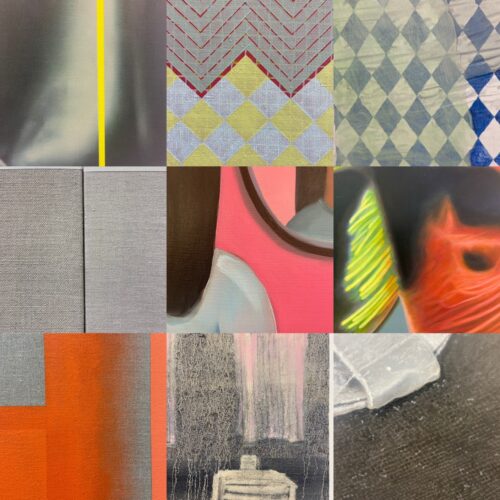
Accidents, appliances and horse hair
This is a post from the weareoca.com archive. Information contained within it may now be out of date.
We’ve just had a visit to the debated Judy Chicago exhibition, at Ben Uri, where there was much discussion about the Jewish and Christian imagery in her work and whether her bright colours, organic shapes and references to the human body evoked comparisons with Frida Khalo. One student made a comparison between Chicago’s recording of her traffic accident and the horrific tram crash that Khalo survived as a young woman. We looked at how Chicago used imagery that related to cleaning and purification and talked about whether her angry drawings recording the events of an unhappy year comprised a consistent record of her state of mind or conjured up a single mood recorded after the event. The group compared this to the diaristic scrapbook quality of Tracey Emin’s work and discussed whether women related to Helen Chadwick’s portrayal of herself trapped inside domestic appliances. Some students felt that the works were more angry and iconoclastic than many women’s works today but had been appropriate to their time, and the movement to establish its own aesthetic. Do women produce work that is overtly protesting and angry today? 
Some students went on to a retrospective exhibition of British women’s work from the 1970’s at the Richard Saltoun Gallery while others went to an exhibition of Asian, African and South American textiles at SOAS.
The photographs at the Richard Saltoun Gallery were mainly records of performance works performed by actors under the direction of the artists. They included Rose English’s Quadrille of 1975 in which she trained five women to perform a synchronised dance at a country horse show that equated the artificial expectations imposed on women with the stylised movements of equestrianism. The participants in the performance were dressed as horses in tunics, hoof high-heels and horses’ tails. Alexis Hunter’s Domestic Warfare of 1978 reprised part of a 160 slide installation which showed a marriage turning sour and violent. In a separate work she recreated a real or imagined attempted rape by an attacker in ways that brought together, albeit somewhat clumsily, the sexual and racial politics of the decade. The most daring and, perhaps, the most successful of the pieces was documentation by the American artist, Carolee Schneemann. She stripped off during a train ride from London to Edinburgh and roller-skated naked through the carriages whilst reciting from Wittgenstein’s TractatusLogico-Philosophicus.

The spectacular exhibition at SOAS included divinely-inspired dream works by contemporary Malaysian textile workers, working with banana and pineapple fibres in natural colours derived from plants, roots, stones and molluscs. Many of these Iban weavers – like their fellow exhibitors from China, Nepal and Cambodia – made the works while sitting on the floor by bracing the warp against their backs and interlacing the fibres with their fingers. There were also examples of felt, bark-cloth and dyed textiles and of textile jewellery made from plants, seeds and horse hair. In contrast to the other two exhibitions, which addressed the role of women in the west, the exhibition highlighted the role of women workers in traditional communities that are threatened by the dumping of cheap textile products through globalisation.
A rich and inspiring visit that examined the changing roles of women in art and design across a century and spanning continents.
Top image Judy Chicago, bottom image textile work from SOAS.






A great day with Pat and Gerald, especially at the SOAS. Wonderful fine stitching that made me wonder that human hands could produce such delicate and intricate work!
First time that I had met both Tutors who were friendly, helpful and full of knowledge. They made me feel comfortable within the group and able to contribute to the discussion. Thank you both.
‘Do women produce art that is overtly protesting and angry today?’ I think far less so. It may well be a sign of the times or a changing attitude to politics. More work may be made (by women and men) about threats to the environment than was made thirty or forty years ago. A lot of art now may make oblique, open- ended or ambiguous comments about important issues (for example war), without being obviously angry. I think it is a bit of a shame- I like a good angry piece of work. I wonder if a lot of artists see that as dated?
Before anyone says it before me- so, Rose English has a lot to answer for. What would she think of the Gangnam Style craze that has recently swept the world?